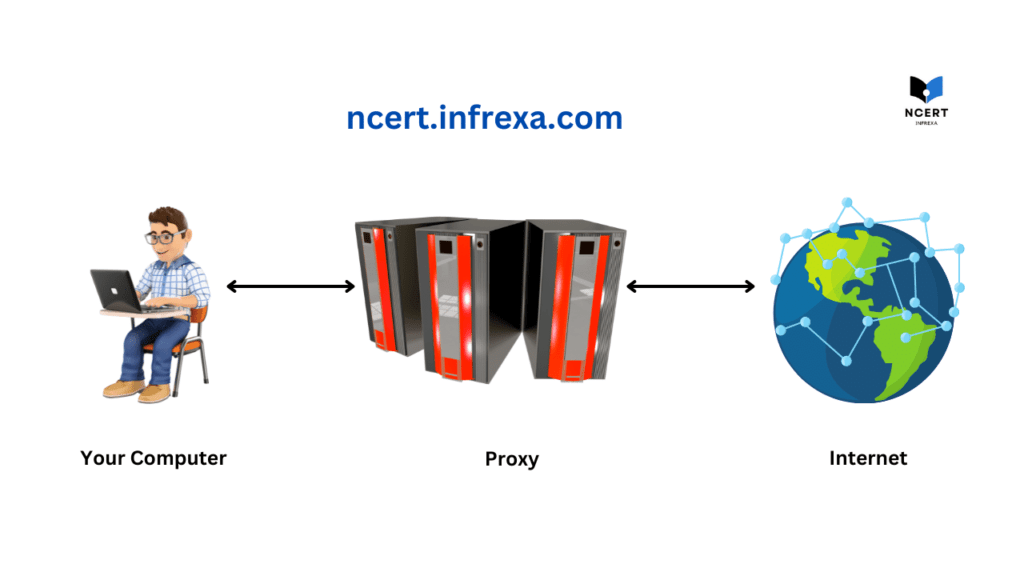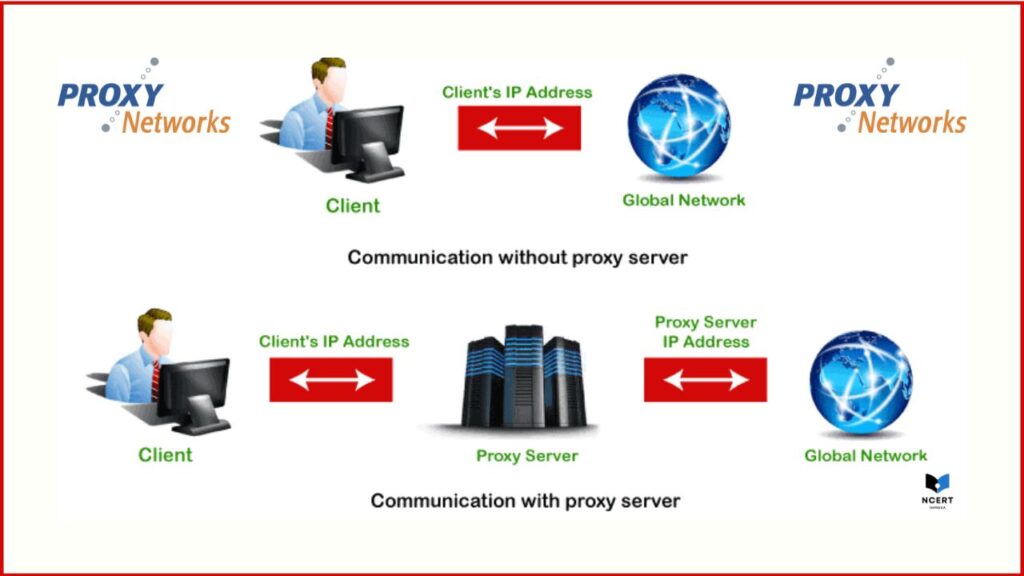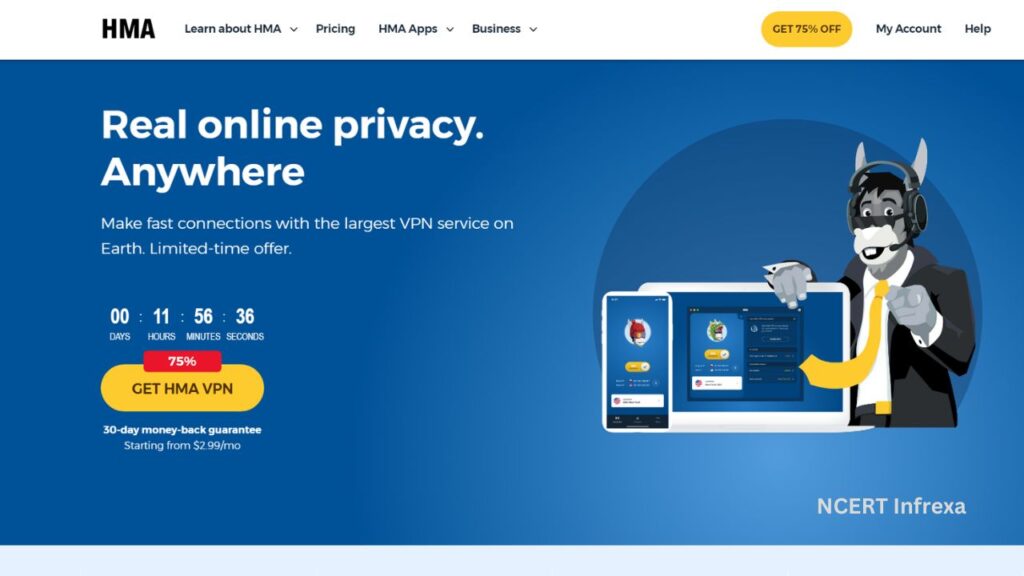A proxy server is a computer that acts as an intermediary between your computer and the Internet. When you access the Internet, your computer first connects to the proxy servers and then requests the resources you want to access. The proxy servers then fetch the resources from the website and return them to your computer.
Proxy servers serve various purposes, such as filtering web content, caching web pages, or streaming media content from another country. They provide an additional layer of security and privacy. They can also be used to bypass firewall restrictions, for example, to access a blocked website at a school or office.

In essence, a reputable proxy server allows you to access websites that may be blocked in your country or region without any issue. It also enables you to browse the web anonymously, without revealing your real IP address
How does a Proxy Server work?
Here’s how it works:
- Client Sends Request: When a client wants to access a website, download a file, or perform any online activity, it sends a request to the proxy server rather than directly to the destination server. This request could be for a web page, a file, or any other resource.
- Proxy Intercepts Request: The proxy server intercepts the client’s request. It can then analyze the request, modify it if necessary, or simply forward it to the destination server.
- Proxy Forwards Request: The proxy server acts as a middleman, forwarding the client’s request to the destination server. The destination server could be a website server, a file server, an email server, or any other type of server hosting the desired content or service.

- Destination Server Responds: The destination server processes the request and sends a response back to the proxy server. This response could be a web page, a file, or any other content requested by the client.
- Proxy Receives Response: The proxy server receives the response from the destination server. It can then analyze, modify, or cache the response before sending it back to the client.
- Proxy Sends Response to Client: The proxy server sends the response it received from the destination server back to the client. The client interprets the response as if it came directly from the destination server.
Different Types of Proxy Servers
Here are different types of proxy servers:
- HTTP Proxy: Also known as a web proxy, this type of proxy is specifically designed for web traffic. It intercepts and forwards HTTP requests and responses between clients and servers. It’s commonly used to control access, filter content, and enhance performance by caching web pages.
- HTTPS Proxy: Similar to an HTTP proxy, but designed to handle secure HTTPS traffic. It encrypts the connection between the client and the proxy server, which then decrypts the traffic and sends it to the destination server.
- SOCKS Proxy: SOCKS (Socket Secure) is a protocol that operates at a lower level than HTTP proxies. SOCKS proxies can handle various types of traffic, not just web traffic. They’re often used for applications that need to tunnel different types of data through the proxy, such as online gaming or file sharing.
- Transparent Proxy: This type of proxy doesn’t require any configuration on the client side. It intercepts traffic without the user’s knowledge and can be used for various purposes, such as content filtering or caching. Users’ requests are automatically forwarded to the proxy server.
- Anonymous Proxy: An anonymous proxy server hides the user’s IP address from the server they are accessing. It doesn’t disclose the original IP of the user, enhancing privacy.
- Elite Proxy: Also known as a high-anonymity proxy, an elite proxy server not only hides the user’s IP address but also conceals the fact that a proxy server is being used. This provides the highest level of anonymity.
- Forward Proxy: A forward proxy is used by clients to access resources on the internet. It’s commonly used in corporate networks to control and monitor outgoing traffic.
- Reverse Proxy: A reverse proxy sits in front of web servers and handles incoming requests from clients. It can provide load balancing, SSL termination, caching, and security features, effectively acting as a gateway between users and servers.
- Caching Proxy: This proxy server stores copies of web pages and resources locally, so when subsequent requests for the same content are made, it can deliver them quickly from its cache rather than fetching them from the original server.
- Content Filtering Proxy: Content filtering proxies are used to restrict access to specific websites or types of content. They are often used in organizations, schools, or public networks to enforce content policies.
- Anonymizing Proxy: These proxies add an extra layer of anonymity by removing identifying information from client requests, making it harder to trace back to the original user.
- Load Balancing Proxy: Load balancing proxies distribute incoming network traffic across multiple servers to optimize resource utilization and ensure high availability.
How to Use Proxy Servers?
Using a proxy server involves configuring your device or software to route your internet traffic through the proxy server’s intermediary.
The exact steps to use a proxy server can vary depending on the type of device, operating system, and software you’re using. Here’s a general guide on how to set up and use a proxy server:
1. Choose a Proxy Server
First, you need to select a proxy server to use. You can either use a free proxy server or opt for a paid proxy service. Keep in mind that free proxies might be less reliable and secure than paid options.
2. Obtain Proxy Server Information
- Obtain proxy server details: Before starting, acquire the IP address and port number of the proxy server you’ll use. These are typically provided by your network administrator or proxy service provider.
- Authentication: Some proxies require authentication (username and password). If necessary, have those credentials ready.
3. Configure Proxy Settings
Once you have obtained Proxy Server Information. Here’s a guide on how to set up proxy servers on different devices:
Windows
- Go to the “Control Panel.”
- Click on “Network and Sharing Center.”
- Click “Internet Options.”
- In the “Internet Properties” window, go to the “Connections” tab.
- Click on the “LAN settings” button.
- Check the box for “Use a proxy server for your LAN.”
- Enter the proxy server’s IP address and port number in the appropriate fields.
- If authentication is required, click the “Advanced” button to enter the username and password.
macOS
- Go to the Apple menu and select “System Preferences.”
- Click on “Network.”
- Select your active network connection (e.g., Wi-Fi) and click “Advanced.”
- Go to the “Proxies” tab.
- Choose the proxy protocol you’re using (HTTP, HTTPS, SOCKS, etc.).
- Enter the proxy server’s details (IP address, port number) in the provided fields.
- If authentication is required, enter the username and password.
Chrome Browser (Windows, macOS, Linux)
- Launch the Chrome web browser.
- Click the three dots in the top right corner, then select “Settings.”
- Scroll down and click on “Advanced” to expand more options.
- Under “System,” click on “Open proxy settings.”
- In the “Internet Properties” window, click on the “LAN settings” button.
- Check the box for “Use a proxy server for your LAN.”
- Enter the IP address and port number of your proxy server in the respective fields.
- Check the box for “Bypass proxy server for local addresses” if required.
- Click “OK” on both windows to save the settings.
Android
- Access your device’s settings app.
- Tap on “Wi-Fi” or “Network & Internet.”
- Long press on the Wi-Fi network you’re connected to.
- Select “Modify network.”
- Check the box for “Show advanced options.”
- Tap on “Proxy” and select “Manual.”
- Input the IP address and port number of your proxy server.
- Tap “Save” to apply the settings.
iOS
- Go to your device’s settings app.
- Tap on “Wi-Fi.”
- Tap on the Wi-Fi network you’re connected to.
- Scroll down and tap on “Configure Proxy.”
- Select “Manual.”
- Input the IP address and port number of your proxy server in the respective fields.
- Tap “Save” to apply the settings.
4. Test the Proxy Connection
After configuring the proxy settings, it’s a good idea to test the connection to ensure everything is working as expected. Open a web browser and try accessing a website to see if it loads through the proxy server.
5. Troubleshooting
If you encounter issues, double-check the proxy server details, including the IP address, port number, and authentication credentials. Ensure that the proxy server you’re using is functioning properly.
How to Choose the Right Proxy Server?
Choosing the right proxy server involves considering your specific needs, whether it’s for privacy, security, accessing blocked content, or optimizing network performance. Here are some factors to consider when selecting a proxy server:
1. Purpose and Use Case: Identify why you need a proxy server. Are you looking for enhanced privacy, access to geo-restricted content, improved security, or something else? Different use cases might require different types of proxy servers.
2. Reliability and Reputation: Choose a reputable proxy server provider with a history of reliable service. Research reviews and user experiences ensure that the provider is trustworthy and doesn’t engage in unethical practices.
3. Performance and Speed: Consider the proxy server’s performance and speed. Some proxy servers might introduce latency, leading to slower internet connections. Look for providers that offer high-speed connections.
4. Location Options: If you’re using a proxy server to access geo-restricted content, ensure that the provider has servers in the desired locations. This is particularly important for bypassing location-based restrictions.
5. Server Locations: Consider the physical locations of the proxy servers. Choosing a server that’s physically closer to you can lead to better performance and lower latency.
6. Security Features: If security is a concern, look for proxy servers that offer features like encryption, malware filtering, and protection against cyber threats.
7. Pricing: Evaluate the pricing plans of different proxy server providers. Free proxies might have limitations and potential risks, so consider investing in a paid service if your needs are more demanding.
8. Trial Periods: Look for providers that offer trial periods or money-back guarantees. This allows you to test the service and see if it meets your requirements before committing.
9. Customer Support: Good customer support can be invaluable if you encounter issues or have questions about the service. Check whether the provider offers reliable customer support channels.
10. Compatibility: Ensure that the proxy server works with the devices and software you plan to use. Some providers might have limitations in terms of compatibility with specific platforms.
11. User Interface and Ease of Use: A user-friendly interface and straightforward setup process can make using the proxy server more convenient, especially for less tech-savvy users.
Pros and Cons of Using Proxy Server (s)
Pros:
- Enhanced Privacy: Proxy servers can mask your IP address, making it more difficult for websites and services to track your online activities. This can provide a certain level of anonymity and privacy.
- Access to Restricted Content: Proxy servers can allow you to access content that might be blocked or restricted in your region or network. By connecting through a proxy server in a different location, you can bypass such restrictions.
- Improved Security: Some proxy servers offer security features like content filtering, malware scanning, and intrusion detection, which can help protect your device from malicious content and cyber threats.
- Faster Speeds: Caching proxies store copies of frequently accessed content, which can lead to faster load times for websites and resources. This is especially useful for organizations with multiple users accessing the same content.
- Bandwidth Savings: Caching and compressing content can reduce the amount of data transferred between your device and the destination server, resulting in reduced bandwidth usage.
- Load Balancing: For businesses and large networks, load balancing proxies distribute incoming traffic across multiple servers, ensuring better resource utilization and improved performance.
- Content Filtering: Proxy servers can be configured to filter out unwanted or inappropriate content, making them useful for schools, workplaces, and public networks.
Cons:
- Reliability Issues: If the proxy server experiences downtime or malfunctions, it can disrupt your ability to access websites and services.
- Data Privacy Concerns: While proxy servers can offer privacy benefits, it’s important to choose a reputable proxy provider that doesn’t log or misuse your data.
- Potential for Misuse: Proxy servers can be used to engage in illegal activities or to bypass security measures. Some users might exploit proxy servers for unethical purposes.
- Performance Impact: In some cases, using a proxy server might slow down your internet connection due to the additional layer of communication and potential server load.
- Compatibility Issues: Some websites and online services might not work properly when accessed through a proxy server, as they might be designed to interact directly with clients.
- Security Risks: If not properly configured, a proxy server can introduce security vulnerabilities, especially if it’s not kept up to date with security patches.
- Limited Anonymity: While proxy servers can hide your IP address, determined parties can still trace your online activities back to you, particularly if advanced tracking techniques are used.
- Inaccurate Geo-Targeting: Using a proxy server to access content from a different location can lead to inaccurate geolocation-based services or content recommendations.
- Dependence on Proxy Provider: If you’re using a third-party proxy provider, you’re relying on their service’s availability, performance, and security practices.
Alternatives
There are 4 alternatives to a Proxy Service:
- Virtual Private Network (VPN)
- Tor (The Onion Router)
- Node Unblocker
- DNS Over HTTPS (DoH) and DNS Over TLS (DoT)
Recommended for you:




